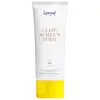What's inside
What's inside
 Key Ingredients
Key Ingredients

 Benefits
Benefits

 Concerns
Concerns

 Ingredients Side-by-side
Ingredients Side-by-side

Butyl Methoxydibenzoylmethane 3%
UV AbsorberHomosalate 7%
Skin ConditioningEthylhexyl Salicylate 5%
UV AbsorberOctocrylene 10%
UV AbsorberAletris Farinosa Root Extract
AntioxidantBisabolol
MaskingButyloctyl Salicylate
Skin ConditioningCalcium Sodium Borosilicate
Caprylhydroxamic Acid
Caprylic/Capric Triglyceride
MaskingCaprylyl Glycol
EmollientCetearyl Alcohol
EmollientCoco-Caprylate/Caprate
EmollientCoco-Glucoside
CleansingCoconut Alkanes
EmollientErythritol
HumectantEthyl Ferulate
AntioxidantEthylhexyl Methoxycrylene
Skin ConditioningGlycerin
HumectantGlyceryl Stearate
EmollientHydrogenated Polycyclopentadiene
Methyl Dihydroabietate
Mica
Cosmetic ColorantPolyester-8
Skin ConditioningPropanediol
SolventSodium Gluconate
Skin ConditioningSodium Polyacrylate Starch
AbsorbentSodium Stearoyl Glutamate
CleansingTitanium Dioxide
Cosmetic ColorantTocopherol
AntioxidantWater
Skin ConditioningXanthan Gum
EmulsifyingButyl Methoxydibenzoylmethane 3%, Homosalate 7%, Ethylhexyl Salicylate 5%, Octocrylene 10%, Aletris Farinosa Root Extract, Bisabolol, Butyloctyl Salicylate, Calcium Sodium Borosilicate, Caprylhydroxamic Acid, Caprylic/Capric Triglyceride, Caprylyl Glycol, Cetearyl Alcohol, Coco-Caprylate/Caprate, Coco-Glucoside, Coconut Alkanes, Erythritol, Ethyl Ferulate, Ethylhexyl Methoxycrylene, Glycerin, Glyceryl Stearate, Hydrogenated Polycyclopentadiene, Methyl Dihydroabietate, Mica, Polyester-8, Propanediol, Sodium Gluconate, Sodium Polyacrylate Starch, Sodium Stearoyl Glutamate, Titanium Dioxide, Tocopherol, Water, Xanthan Gum
Butyl Methoxydibenzoylmethane 2.9%
UV AbsorberHomosalate 4%
Skin ConditioningEthylhexyl Salicylate 4.9%
UV AbsorberOctocrylene 9.5%
UV AbsorberAlcohol
AntimicrobialBrassica Campestris Seed Oil
Skin ConditioningButyloctyl Salicylate
Skin ConditioningCamelina Sativa Seed Oil
Skin ConditioningCarthamus Tinctorius Seed Oil
MaskingEthyl Ferulate
AntioxidantLimnanthes Alba Seed Oil
Skin ConditioningMauritia Flexuosa Fruit Oil
Skin ConditioningOpuntia Ficus-Indica Flower Extract
Skin ConditioningRubus Idaeus Seed Oil
EmollientVa/Butyl Maleate/Isobornyl Acrylate Copolymer
Butyl Methoxydibenzoylmethane 2.9%, Homosalate 4%, Ethylhexyl Salicylate 4.9%, Octocrylene 9.5%, Alcohol, Brassica Campestris Seed Oil, Butyloctyl Salicylate, Camelina Sativa Seed Oil, Carthamus Tinctorius Seed Oil, Ethyl Ferulate, Limnanthes Alba Seed Oil, Mauritia Flexuosa Fruit Oil, Opuntia Ficus-Indica Flower Extract, Rubus Idaeus Seed Oil, Va/Butyl Maleate/Isobornyl Acrylate Copolymer
Ingredients Explained
These ingredients are found in both products.
Ingredients higher up in an ingredient list are typically present in a larger amount.
Also known as Avobenzone, this ingredient is a chemical sunscreen filter that provides protection in the UV-A range.
Avobenzone is globally approved and is the most commonly used UV-A filter in the world.
Studies have found that avobenzone becomes ineffective when exposed to UV light (it is not photostable; meaning that it breaks down in sunlight). Because of this, formulations that include avobenzone will usually contain stabilizers such as octocrylene.
However, some modern formulations (looking at you, EU!) are able to stabilize avobenzone by coating the molecules.
Avobenzone does not protect against the UV-B range, so it's important to check that the sunscreen you're using contains other UV filters that do!
The highest concentration of avobenzone permitted is 3% in the US, and 5% in the EU.
Learn more about Butyl MethoxydibenzoylmethaneButyloctyl Salicylate is a chemical UV filter structurally similar to octisalate. It is a photostabilizer, SPF booster, emollient and solvent. This ingredient helps evenly spread out ingredients.
According to a manufacturer, it is suitable for pairing with micro Titanium Dioxide, Zinc Oxide, and pigments.
Photostabilizers help stabilize UV-filters and prevents them from degrading quickly.
Learn more about Butyloctyl SalicylateEthyl ferulate is an antioxidant derived from ferulic acid and ethyl alcohol. You'll most likely see this ingredient in sunscreens.
One study from 2014 found a concentration of 10% showed a similar SPF to Benzimidazole. Though this is considered a chemical UV filter, this ingredient is not listed as so. This is due to regulatory loopholes. You'll likely find this ingredient in "100% mineral" sunscreens.
This ingredient is typically found in concentrations between 0.5-1%. It is usually created synthetically or from rice bran oil.
Learn more about Ethyl FerulateEthylhexyl Salicylate is an organic compound used to block UV rays. It primarily absorbs UVB rays but offers a small amount of UVA protection as well.
Commonly found in sunscreens, Ethylhexyl Salicylate is created from salicylic acid and 2-ethylhexanol. You might know salicylic acid as the effective acne fighter ingredient and BHA.
The ethylhexanol in this ingredient is a fatty alcohol and helps hydrate your skin, similar to oils. It is an emollient, which means it traps moisture into the skin.
According to manufacturers, Ethylhexyl Salicylate absorbs UV wavelength of 295-315 nm, with a peak absorption at 307-310 nm. UVA rays are linked to long term skin damage, such as hyperpigmentation. UVB rays emit more energy and are capable of damaging our DNA. UVB rays cause sunburn.
Learn more about Ethylhexyl SalicylateHomosalate is a chemical sunscreen filter that provides protection in the UV-B range (280nm - 320 nm), with a peak protection at 306 nm. It is internationally approved for use in sunscreens.
Homosalate is not photo-stable, meaning it's strength as a UV filter degrades over time with exposure to the sun. Because of this, it's often used in combination with other chemical sunscreen filters as avobenzone (which protects from the UV-A range). Homosalate also helps act as a solvent for harder-to-dissolve UV filters.
(Part of the reason that sunscreens need to be frequently re-applied is due to the photo instability of many chemical sunscreen filters)
Currently, homosalate is approved in concentrations up to 10% in the EU and 15% in the US. The FDA is currently doing further research on the effects of homosalate, and it is possible that these approved concentrations will change in the future.
Learn more about HomosalateOctocrylene protects skin from sun damage. It absorbs UV-B with peak absorption of 304 nm. It is a common sunscreen ingredient and often paired with avobenzone, a UVA filter. This is because octocrylene stabilizes other sunscreen ingredients by protecting them from degradation when exposed to sunlight. Octocrylene is a photostable ingredient and loses about 10% of SPF in 95 minutes.
Octocrylene also acts as an emollient, meaning it helps skin retain moisture and softens skin. It is oil-soluble and hydrophobic, enhancing water-resistant properties in a product.
Those who are using ketoprofen, a topical anti-inflammatory drug, may experience an allergic reaction when using octocrylene. It is best to speak with a healthcare professional about using sunscreens with octocrylene.
The EU allows a maximum of these concentrations:
Learn more about Octocrylene